
- Mirror Universe
- View history

The alternate USS Enterprise at warp
Warp drive or warp engine was a technology that allowed space travel at faster-than-light speeds. It worked by generating warp fields to form a subspace bubble that enveloped the starship , distorting the local spacetime continuum and moving the starship at velocities that could greatly exceed the speed of light . These velocities were referred to as warp factors . Warp drive was the most common form of interstellar propulsion used in the Milky Way Galaxy , making interstellar civilization, exploration, and commerce possible. By the 24th century, warp was the primary means of interstellar transport , but scientists from various cultures were pursuing various alternative propulsion methods that were hypothetically faster or more efficient.
- 1 Etymology
- 2.1 Parts of the system
- 2.2 System types
- 3.1 21st century
- 3.2 22nd century
- 3.3 23rd century
- 3.4 24th century
- 3.5 ...and beyond
- 4.1 Background information
- 4.2 External links

Etymology [ ]

The USS Discovery at warp in 2257

The USS Stargazer performs a warp jump
In 2063 , the term "warp drive" was already used by Zefram Cochrane of his engine on the Phoenix . However, Cochrane used the term "space warp generator" in the monitor displays on his spacecraft. ( Star Trek: First Contact ) Even as late as the 2150s , the warp five engine was still officially known as a " gravimetric field displacement manifold" ( ENT : " Cold Front ").
Most cultures throughout the Milky Way Galaxy used the term "warp drive" and by the late- 23rd century it was the most common term used by the Federation as well ( Star Trek: The Original Series , et al.). In the 2250s the term "hyperdrive" was used by Starfleet , ( TOS : " The Cage ") and the Ferengi occasionally used the term "lightspeed drive". ( TNG : " Peak Performance ") Finally, there was the term "star drive" which was only used by the Federation and Starfleet in the 2260s. ( TOS : " Bread and Circuses ", " The Paradise Syndrome ")
Space warp was one of the vocabulary words listed on the chart "A Tunnel in the Sky". This chart was seen in the schoolroom aboard Deep Space 9 in 2369 . ( DS9 : " In the Hands of the Prophets ")
The process of going to warp was described as a warp jump . ( ENT : " Horizon "; TNG : " Peak Performance ", et al.)
Technology [ ]
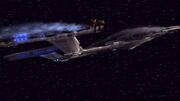
Enterprise with a disabled warp engine
Warp engines were the bulky units found, in many cases, in a starship's nacelle . ( TNG : " New Ground ")
24th century Federation warp engines were fueled by the reaction of matter ( deuterium ) and antimatter ( antideuterium ), mediated through an assembly of dilithium crystals, which were nonreactive with antimatter when subjected to high-frequency electromagnetic fields . This reaction produced a highly energetic plasma , called electro-plasma or warp plasma , which was channeled by plasma conduits through the electro-plasma system (EPS); that system also provided the primary energy supply for the ships other electronic systems. For propulsion the electro-plasma was funneled by plasma injectors into a series of warp field coils , usually located in remote warp nacelles . These coils were composed of verterium cortenide and generated the warp field .
Other civilizations used different power sources, such as the Romulans ' use of artificial quantum singularities to power their warp drives, ( TNG : " Timescape ") but the basic process was similar. In some vessels, such as the Intrepid -class , the nacelles were mounted on variable geometry pylons . ( VOY : " Caretaker ")
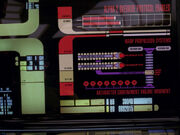
A display showing the main components of a warp drive
Parts of the system [ ]
- Antimatter containment
- Antimatter inducer
- Antimatter relay
- Deuterium cartridges
- Deuterium control conduit
- Electro-plasma
- Emergency shutdown trips
- Main stage flux chiller
- Magnetic interlock
- Bussard collectors
- Plasma injector
- Nullifier core
- Pre stage flux chiller
- Phase inducer
- Plasma conduit
- Plasma coolant
- Plasma regulator
- Power transfer conduit
- Power transfer grid
- Space matrix restoration coil
- Warp field generator
- Warp plasma conduit
- Antimatter injector
- Antiproton injection seal
- dilithium articulation frame
- dilithium chamber hatch
- dilithium crystal
- dilithium regulator
- Intermix chamber
- Matter injector / deuterium injector
- Theta-matrix compositor
System types [ ]
- Class 7 warp drive
- Class 9 warp drive
- Enhanced warp drive
- S-2 graf unit
- Subspace resonator
- Tetryon plasma warp drive
- Tricyclic plasma drive
- Warp five engine
- Warp three engine
- Yoyodyne pulse fusion
Development [ ]
Warp drive and other faster-than-light (FTL) propulsion technologies were the linchpin of an interstellar civilization, making trade and exploration across vast interstellar distances viable. Without these technologies, these distances could not be crossed in any reasonable period of time, making interstellar civilization usually limited to a single sector. ( TNG : " A Matter Of Time ") To put this in perspective, planets that were years away with impulse speeds could be reached in days with ships equipped with warp drive. ( TOS : " Where No Man Has Gone Before ")
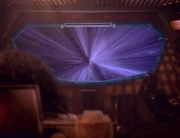
The IKS Rotarran accelerates to warp, viewed from within the vessel
Cultures in the galaxy discovered warp drive at their own pace and rate of development, as most of the cultures had to do. The Vulcans were an interstellar civilization by 9th century BC and had reached the level of warp 7 by 2151 . ( ENT : " The Andorian Incident ", " Fallen Hero "; DS9 : " Little Green Men ") Klingons had interstellar travel capability around the time of Kahless in the 9th century . They had achieved the capability of warp 6 by 2151. ( TNG : " Rightful Heir "; DS9 : " Little Green Men "; VOY : " Day of Honor "; ENT : " Judgment ") Romulans were once considered a group of petty thugs and warp drive was regarded as the key technology that allowed the founding of the Romulan Star Empire . ( Star Trek: Insurrection ) The Vissians developed warp drive around the 12th century . ( ENT : " Cogenitor ") The Borg in the Delta Quadrant began to establish their interstellar collective by the 15th century . ( VOY : " Dragon's Teeth ") In the Alpha Quadrant, the rapid progress of Humanity in the 22nd century led to the wide-scale exploration of the galaxy being one of the basic goals of the United Federation of Planets , founded in 2161 .
The development of the warp drive was recognized by the United Federation of Planets as the marker of an advanced society. It was only after a people developed warp drive that the Federation made contact, as codified in the Prime Directive . ( TNG : " First Contact ") A warp capable society was deemed technically and psychologically ready to embrace the universe at large.
According to Science Officer Spock in 2259 , not once in the entire history of first contact had warp been first developed as anything but a drive. However, the Kiley had developed warp in the form of a warp bomb . ( SNW : " Strange New Worlds ")
21st century [ ]

Phoenix goes to warp
On Earth , warp drive was initially developed by Zefram Cochrane , in the period following World War III . ( Star Trek: First Contact )
The spacecraft credited with discovering the space warp phenomenon was the Bonaventure . ( DS9 : " The Nagus ", production art )
Despite the hardships imposed by the war's aftermath and the lack of advanced materials, Cochrane was able to build a manned warp-capable vessel using a converted Titan II missile. The successful first flight of his ship – the Phoenix – took place on April 5 , 2063 , and drew the attention of a Vulcan exploratory vessel, leading to the event known as First Contact . ( Star Trek: First Contact )
The Bonaventure then became the first deep-space starship to have warp drive installed. ( TAS : " The Time Trap ")
22nd century [ ]
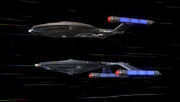
Two NX-class starships in tandem warp flight
Development of warp technology by humans proceeded slowly over the next eighty years, after the flight of the Phoenix – due, in no small part, to the cautious advice of the Vulcans – and it was not until the 2140s that a warp engine developed by Henry Archer at the Warp Five Complex could exceed warp factor 2.
This engine was successfully tested in the second NX prototype by Commanders A.G. Robinson and Jonathan Archer to a speed of warp 2.5, breaking the so-called " warp 2 barrier " in 2143 . Eight months later, Duvall achieved warp 3 with the NX Delta . Warp 4 was first achieved by the USS Franklin . ( ENT : " First Flight "; Star Trek Beyond )
By the year 2149 , warp technology was sufficiently advanced to begin the construction of Enterprise , a vessel capable of warp 5 and launched in 2151 . ( ENT : " Broken Bow ") Although Enterprise was at first unable to fully realize this potential (maxing out at warp 4.7), the starship finally reached warp 5 on February 9 , 2152 . ( ENT : " Fallen Hero ")
By 2161 , Starfleet warp drive technology had achieved the capability to reach warp 7, and these engines were being built into the latest class of Starfleet vessels as the NX-class ships were being decommissioned. ( ENT : " These Are the Voyages... ")
23rd century [ ]

The USS Shenzhou at warp in 2256
Development and improvement of warp drive continued apace, and by the 2240s , Starfleet vessels of the Constitution -class had standard cruising speeds of warp 6 and emergency speeds as high as warp 8 (although under the right conditions, the engines could reach warp 9). These ships took advantage of a major breakthrough in warp technology that took place between 2236 and 2254 , the breaking of the so-called " time barrier ". ( TOS : " The Cage ")
Higher warp factors continued to be reached, mostly through alien intervention, or dangerous malfunction. The USS Enterprise was modified by the Kelvans to maintain a speed of warp 11 in 2268 . Later that year, the Enterprise accelerated to a speed of warp factor 14.1, after being sabotaged by a Kalandan planetary defense system . At that velocity, however, the ship came within moments of destroying itself. ( TOS : " By Any Other Name ", " That Which Survives ")
At around the same time, warp engines were being redesigned to allow standard speeds of warp 8 and above. During the refit of the Constitution -class, the cylindrical-shaped nacelles were replaced with a new flattened design. Engines required precise tuning; imbalanced engines caused a wormhole effect that almost destroyed Enterprise on its first mission after refit. ( Star Trek: The Motion Picture )

The USS Enterprise -A jumps to warp to escape an incoming photon torpedo
Warp theory continued to advance with the development of the first transwarp drive engines in the mid- 2280s , which would have theoretically allowed greater efficiency and any warp speed to be available for a ship. However, the transwarp experiment of USS Excelsior ended in failure, and the technology was abandoned at that time. The Excelsior itself was deemed spaceworthy, retrofitted with conventional warp drive and commissioned as NCC-2000 under the command of Captain Hikaru Sulu . ( Star Trek III: The Search for Spock ; VOY : " Threshold "; Star Trek VI: The Undiscovered Country )
24th century [ ]
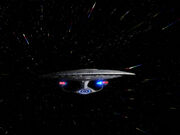
The USS Enterprise -D at warp
At some point in the 24th century, a new warp factor scale came into use, which placed warp 10 as a theoretical maximum. ( VOY : " Threshold ")
By the time the Galaxy -class starship was being designed in the 2360s , warp technology had progressed to the point where speeds of warp 9.6 could be sustained for up to twelve hours, although warp 9.2 was considered the "red line." ( TNG : " Encounter at Farpoint ")
In 2367 , the warp drive on the Galaxy -class starship was managed by the warp propulsion power system . In that year, when Data hijacked the USS Enterprise -D , he issued a command override on this system giving him complete control of the system from the bridge . ( TNG : " Brothers ")
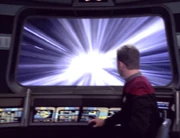
Voyager accelerates to warp
The USS Voyager was capable of a top cruising speed of warp 9.975. ( VOY : " Caretaker ", " Relativity ")
The USS Prometheus was capable of a sustained cruising speed of warp 9.9. ( VOY : " Message in a Bottle ")
In 2370 , the Hekaran scientist Serova discovered that the use of conventional warp engines caused damage to the fabric of spacetime. The Federation Council imposed a speed limit of warp factor 5 on all Federation vessels in all but extreme emergency cases, such as medical emergencies. A conspiracy theory posit by Steve Levy suggested that the discovery of this was part of a Vendorian morality test ( TNG : " Force of Nature ", " The Pegasus ", " Eye of the Beholder ", LD : " Caves ")
It was not until 2372 , that the transwarp threshold was broken by the Federation. Tom Paris of the USS Voyager managed to achieve infinite velocity on the shuttlecraft Cochrane . However, this form of travel was found to have severe, unanticipated side effects . ( VOY : " Threshold ")
...and beyond [ ]
In what was originally the future which was observed and altered by Jean-Luc Picard , speeds of at least warp 13 were possible. ( TNG : " All Good Things... ")
Appendices [ ]
Background information [ ].
Gene Roddenberry originally intended the Enterprise to become transparent while in warp drive, as depicted in " The Cage " (later reformatted into the two-part "The Menagerie"). The idea was that the ship would be traveling faster than light, which means that light would not reach it, rendering the vessel invisible to the naked eye. However, according to Einstein's Theory of Special Relativity, the speed of light is a constant from any frame of reference; an observer moving at close to c would still observe light moving toward him and away from him at c .
External links [ ]
- Warp drive at StarTrek.com
- Warp drive at Memory Beta , the wiki for licensed Star Trek works
- Hyperdrive at Memory Beta , the wiki for licensed Star Trek works
- Warp drive at Wikipedia
- André Bormanis's explanation of warp drive (X)
- 2 USS Enterprise (NCC-1701-G)
- 3 Star Trek: The Next Generation
July 13, 2021
11 min read
Star Trek ’s Warp Drive Leads to New Physics
Researchers are taking a closer look at this science-fiction staple—and bringing the idea a little closer to reality
By Robert Gast & Spektrum

Warp one, engage!
Getty Images
For Erik Lentz, it all started with Star Trek . Every few episodes of Star Trek: The Next Generation, Captain Jean-Luc Picard would raise his hand and order, “Warp one, engage!” Then stars became dashes, and light-years flashed by at impossible speed. And Lentz, still in elementary school, wondered whether warp drive might also work in real life.
“At some point, I realized that the technology didn’t exist,” Lentz says. He studied physics at the University of Washington, wrote his Ph.D. dissertation on dark matter and generally became far too busy to be concerned with science fiction. But then, at the start of the coronavirus pandemic, Lentz found himself alone in Göttingen, Germany, where he was doing postdoctoral work. He suddenly had plenty of free time on his hands—and childhood fancies in his head.
Lentz read everything he could find on warp drives in the scientific literature, which was not very much. Then he began to think about it for himself. After a few weeks, something occurred to him that everyone else seemed to have overlooked. Lentz put his idea on paper and discussed it with more experienced colleagues. A year later it was published in a physics journal .
On supporting science journalism
If you're enjoying this article, consider supporting our award-winning journalism by subscribing . By purchasing a subscription you are helping to ensure the future of impactful stories about the discoveries and ideas shaping our world today.
It quickly became clear that Lentz was not the only person dreaming about warp drives. Media outlets all over the world picked up the story , and a dozen journalists asked for interviews. A discussion on the online forum Reddit attracted 2,700 comments and 33,000 likes. One Internet user wrote, “Anyone else feel like they were born 300 years too soon?”
A Bubble in Space and Time
There is no doubt that the universe is still far too vast for humans to traverse. It takes more than four years for a beam of light to reach Earth’s nearest star Proxima Centauri. Even with the best available propulsion systems, it would take tens of thousands of years for a human to get there. One can always dream about establishing colonies in other star systems, but it is not a journey anyone is likely to undertake.
But perhaps one day it might be possible to reduce the travel time. There are many ideas about how to do that, from laser-accelerated solar sails to nuclear propulsion. But even with the aid of these technologies, you would not get too far in a human lifetime. The galaxy really is open only to those who travel as fast as light—or faster.
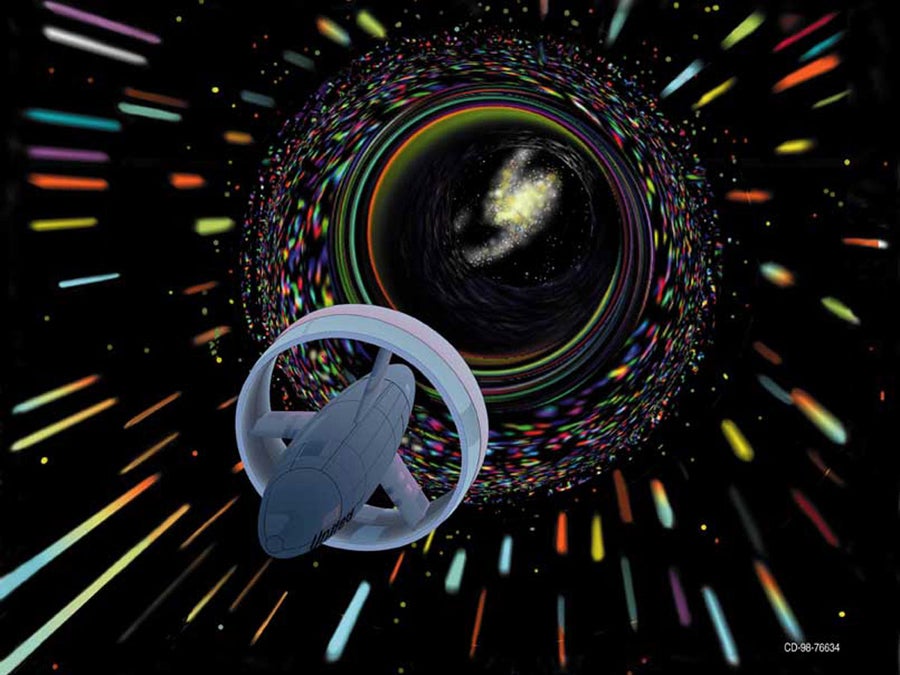
NASA artist’s 1998 rendition of warp drive travel. The ring around the spacecraft generates a negative-energy field. From today’s perspective, the negative-energy field would no longer be necessary. Credit: NASA; Digital art by Les Bossinas (Cortez III Service Corp)
For that very reason, imaginative physicists have long been pondering the ultimate propulsion system: a bubble in space and time in which a spaceship could dash from sun to sun, just like the USS Enterprise did. This is research at the fringe of science: not necessarily wrong but spiced with a large pinch of optimism.
The fact that scientists are dealing with the idea at all today is thanks to a 1994 paper by Mexican theoretical physicist Miguel Alcubierre. At the time, Alcubierre was not just a passionate Star Trek devotee. In his doctoral thesis at the University of Wales College Cardiff (now Cardiff University), Alcubierre also worked on the theory of relativity. Strictly speaking, the theory states that nothing can travel faster than light. But by applying a little creativity, Alcubierre identified an apparent loophole.
For physicists, Albert Einstein’s theory of relativity consists of two parts: The “special” theory of relativity, which dates from 1905, deals with the uniform motion of fast-as-light objects. Ten years later Einstein generalized these ideas for accelerating bodies. According to “general” relativity, the three spatial dimensions we are familiar with (up-down, left-right, front-back) are inseparable from time. Every mass deforms this spacetime.
According to Albert Einstein’s epic discovery, we live in four-dimensional “spacetime.” Spacetime is not static. Like a tablecloth, it is deformed by massive objects. Everything that moves across the tablecloth (or through spacetime) can accelerate only up to the speed limit set by light. The tablecloth itself, on the other hand, can be deformed at any speed, as the universe itself shows in some situations.
At the instant of the big bang, for example, the original spacetime structure presumably expanded for a split second and did so much faster than any ray of light could travel. Even today, the expansion continues to drive extremely distant galaxies away at speeds faster than light, which means their light can no longer reach us.
Based on his discovery, Alcubierre surmised that it would only be a small step to a warp drive. If spacetime were contracted in front of a spaceship and expanded behind it to compensate, it would be possible to travel to one’s destination at a speed faster than light. The ship would remain encapsulated in a bubble, and the crew would not sense the magnitude of the interstellar journey. In a 2017 lecture, Alcubierre compared it to being on a passenger conveyor belt at the airport: “You can imagine that the floor behind you is being created out of nothing and in front of you it is being destroyed, so you move along.”
But formulating this idea in the language of general relativity immediately gives rise to major practical problems. First, to deform spacetime so radically, you would need to cram a huge mass into a bubble bounded by a wall thinner than an atomic nucleus. Then you would need two forms of matter to maintain the bubble. The gravity of ordinary mass would cause the space at the front of the bubble to contract, moving the whole structure forward. But at the same time, the space at the back of the bubble would need to expand like rising bread dough. To make that expansion happen, according to Alcubierre, you would need some form of negative energy radiating a kind of antigravity.
The Curse of Negative Energy
For most physicists, that was the end of the thought experiment. Energy—which according to Einstein’s formula E = mc2 is equivalent to unconstrained mass—seems like it must, by definition, be positive. But according to quantum theory, it can indeed have a negative value. This seems to occur only in rare special cases, however—on a tiny scale. In the so-called Casimir effect , for example, the quantities involved are so minuscule that any technological application seems absurd.
Alcubierre, now a professor of physics at the National Autonomous University of Mexico, concedes this point. In terms of a potential technology, warp drives “are greatly lacking,” he and one of his colleagues wrote in a recent preprint paper . He has now turned his attention to known phenomena, such as black holes. The warp drive concept, however, retains its fascination, especially for Trekkies—and for a few gravitational physicists, who occasionally publish variations on the idea.
Some of these papers have shown how to reduce the bubble’s mass requirements so that the total mass needed to deform spacetime would be less than that of our sun. But no one was able to get around the problem of negative energy—until Lentz took it up during the lockdown in Göttingen. In his enforced isolation, Lentz found a way to construct a warp bubble using only positive energy. In so doing, he may have overcome the greatest objection to warp drives.
What made it possible was a special feature of the geometry of spacetime that Lentz discovered buried in the general theory of relativity—more precisely, in Einstein’s field equations. These equations can calculate how a particular distribution of matter and energy deforms spacetime. Researchers can also use them, as Alcubierre did, to determine the mass and energy needed to produce a specific curvature of space.
Dealing with a dynamic, four-dimensional structure like spacetime is extremely complicated, however. Writing out Einstein’s formulas in full produces a jumble of nested differential equations with thousands of terms. Depending on the assumptions you make about a particular physical situation, you only take some of those terms into account. For theorists, it is an almost limitless playground.
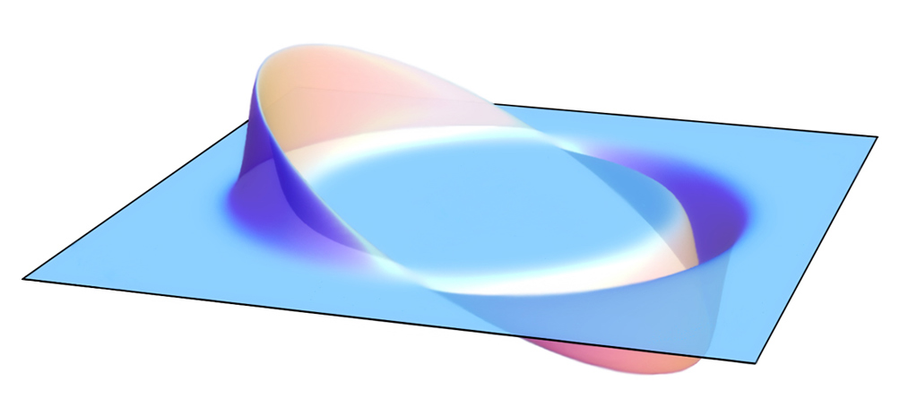
Principle of the Alcubierre drive: Spacetime contracts at the front of the bubble (right), corresponding to a warp in spacetime. Behind the bubble (left), new space is created out of nothing, which is equivalent to stretching spacetime. Credit: AllenMcC Wikimedia (CC BY-SA 3.0)
Lentz specifically examined the assumptions leading to the negative energy requirements in Alcubierre’s work. Like his colleague, Lentz began by analyzing spacetime, modeling the multidimensional substance as a stack of very thin layers. He found that Alcubierre had only considered comparatively simple “linear” relationships between the equations for shifting one layer onto the next. At this point, choosing more complex “hyperbolic” relations, which typically express rapidly changing quantities, results in a different warp bubble than the one obtained by Alcubierre. It still requires enormous amounts of mass and energy but, according to Lentz’s calculations, only positive amounts. “I was very surprised that no one had tried this before me,” Lentz says.
Lentz’s bubble looks different from the one Alcubierre worked out in 1994. It consists of diamond-shaped regions of altered spacetime that resemble a flock of birds. Creating such a spacetime geometry in reality would involve a complicated layering of rings and disks, not made of solid material but of an extremely dense fluid of charged particles, similar to the substance found in the interior of neutron stars, Lentz says.
That means near-light-speed travel is still very, very far away from applied technology. But now that no exotic negative energy densities are needed—at least according to Lentz’s latest work—the theoretical games are within the realm of established physics. Alcubierre describes Lentz’s paper as a “very important development.” Francisco Lobo, a researcher at the University of Lisbon and a colleague of Alcubierre’s, who has published a textbook on warp drives, cannot find any obvious errors either. “If correct, this has the potential of opening up new interest and novel avenues of research in warp drive physics,” he says.
Lentz’s idea has even aroused interest among researchers outside the small community of warp drive enthusiasts, including Lavinia Heisenberg, a professor of cosmology at the Swiss Federal Institute of Technology Zurich. Heisenberg and her student Shaun Fell found Lentz’s paper so exciting that they built on it by designing their own positive-energy warp bubbles that would require as little as a thousandth of the mass of our sun.
“The whole thing is much less mysterious than most people assume,” says Alexey Bobrick , an astrophysicist at Lund University in Sweden. Collaborating with New York City–based entrepreneur Gianni Martire, Bobrick came up with some promising solutions to Einstein’s field equations in 2020. According to Bobrick, all that is needed for a warp bubble is an appropriately shaped shell made of dense material that bends spacetime in its immediate vicinity while the universe through which the bubble moves and the space within the shell remain comparatively undisturbed.
Time Goes by So Slowly
“Comparatively” is the key. Alcubierre and later warp architects assumed an abrupt transition between the contorted spacetime in the wall of the bubble and the smooth interior and exterior. But Bobrick and Martire found this “truncation” of the gravitational field to be the reason why large amounts of negative energy are required to stabilize the contortion of space and time.
Abandoning the cartoonish image of a soap bubble, however, makes it possible to build warp drives based on ordinary matter, they claim. The gravitational field would not simply disappear when one moved away from the wall of the shell. Instead it would gradually decay. Spacetime would therefore also be curved inside the bubble. To travelers in a spaceship right in the middle of the bubble, this phenomenon would be most obvious in the passage of time: their watches would go slower than in the rest of space because, according to the theory of relativity, time is affected by gravity.
The slower passage of time on a spaceship might be something interstellar travelers appreciate. Still, Bobrick and Martire describe other obstacles. So far, they argue, there is no known way to actually accelerate a warp bubble. All previous ideas about the subject simply assume that the curvature of spacetime is already moving at high speed.
A beam of light travels 299,000 kilometers per second. According to Einstein’s special theory of relativity, this is a physical constant. The speed of light is the maximum speed any particle may reach, and a particle can only do so if it has no mass. Consequently, today’s physics offers no possibility of accelerating objects beyond the speed of light. On closer inspection, however, this limit only applies within the four-dimensional spacetime comprising the universe. Outside of that, even greater speeds appear to be possible.
“None of the physically conceivable warp drives can accelerate to speeds faster than light,” Bobrick says. That is because you would require matter capable of being ejected at speeds faster than light—but no known particles can travel that fast. Furthermore, the bubble could not be controlled by occupants of the spaceship itself because they would lose contact with the outside world, owing to the extremely strong curvature of space around them.
Lentz sees these objections as a problem, too, but he believes a solution can be found. Bobrick, meanwhile, points out that it is also possible to travel to distant stars at a third or half the speed of light, especially if time passes more slowly for the people in the warp bubble. Just do not think about the fact that all your relatives left behind on Earth will probably have died of old age before you get back. “But at least the idea is no longer completely crazy,” Bobrick says.
From Theory to Practice
There is still some debate about whether warp bubbles really can do without negative energy. Recently, three theoreticians suggested that this claim was only true for observers moving next to the bubble. Plus, not everything that seems possible according to the theory of relativity actually exists—or is technologically feasible. For example, Einstein’s field equations can also be used to justify “white” holes (the antithesis of their black hole counterparts), Einstein-Rosen bridges (frequently called wormholes) and other exotic alterations in spacetime that no one has ever observed. That could be because laws of nature, as yet unknown, preclude such phenomena.
Some researchers therefore caution against going overboard with the fantasies. Space propulsion expert Martin Tajmar of the Technical University of Dresden, for example, sees no practical relevance for the current work on warp drives. The huge masses involved simply exceed anything that can be tested on Earth, he says.
Most veteran warp drive researchers would undoubtedly agree. They see their work less as preparation for real-world experiments and more as a way of exploring the limits of relativity. In this endeavor, even speculative “thought experiments” are useful, Lobo says.
Lentz, on the other hand, is actively working toward a practical application of his idea. After his research in Göttingen, he took a job at an IT company. But in his spare time, he still thinks about how to accelerate a bend in spacetime to speeds faster than light and how to reduce the energy required to do so.
Lentz also advocates looking closely at the surroundings of neutron stars. It could be that these ultracompact stellar remnants eject bubbles like those that he describes in his paper. “As long as one doesn’t let personal biases get in the way and accepts what evidence tells you, it’s a field of research that is as worthy of being pursued as any other,” he says.
Jean-Luc Picard would probably see it similarly. “Things are only impossible until they are not,” the character noted in an episode of Star Trek: The Next Generation . But that’s also easier to say when you live 300 years in the future.
This article originally appeared in Spektrum der Wissenschaft and was reproduced with permission
- Skip to main content
- Keyboard shortcuts for audio player

- LISTEN & FOLLOW
- Apple Podcasts
- Google Podcasts
- Amazon Music
- Amazon Alexa
Your support helps make our show possible and unlocks access to our sponsor-free feed.
In honor of 'Star Trek: Strange New Worlds' Season 2, a tour of the physics

Regina G. Barber

Berly McCoy

Rebecca Ramirez

Season 2 of the critically acclaimed Star Trek: Strange New Worlds premiered June 15 ( streaming on Paramount+ ). So today, Short Wave boldly goes where many, many nerds have gone before and explores the science — specifically the physics — and the science- fiction of Star Trek . Scientist in Residence Regina G. Barber chats with two Trekkie physicists about why they love the franchise. Astrophysicist Erin Macdonald is the science consultant for Star Trek , and Chanda Prescod-Weinstein is a theoretical physicist and author of the book The Disordered Cosmos .
This episode, the trio discusses the feasibility of warp drive, global cooperation and representation and how the transporters that beam crew members from the surface of a planet to the ship might be breaking fundamental laws of physics. They end at the galaxy's edge — and discuss why its portrayal in Star Trek might be problematic, scientifically.
Space is vast – it takes years for real spacecrafts to travel within our solar system! In Star Trek, characters zip around the galaxy in their starship vessels thanks to warp drive, which let spaceships travel faster than the speed of light. But physics puts a speed limit on anything with mass. These objects have to move slightly slower than the speed of light, which itself has a speed limit. So what's the loophole here?
According to Erin, good ol' suspension of disbelief isn't necessary because, "the math checks out." For that reason, it's one of Erin's favorite pieces of sci-fi in the series. Spacetime is the three dimensions we humans are used to living in, plus time. The universe is situated in the four dimensional fabric of spacetime, with heavier objects "pulling" that fabric down more than lighter — or, weightless, in the case of light — objects. So, spacetime itself could be a loophole to this speed limit. Erin says that to bypass the cosmological speed limit of light, you could simply, "build a bubble of space time around your ship, and then that pushes you faster than the speed of light. " This is the various warp speeds . One bubble for warp 1, another bubble around that first bubble for warp 2 and so on.
Of course, Erin and Chanda both point out that using spacetime in this way requires an extraordinary amount of energy — well beyond what humans are capable of at this moment in time.

'Star Trek: Strange New Worlds' season 2 is a classic sci-fi adventure
Transporters.
It would be great to teleport to work, as Star Trek characters do thanks to their transporters. Upside? No traffic. Downside? The fear that once you've been broken down into particles and beamed across the city, you might not be rearranged in the right order.
In order for a transporter to work, users would have to know both where a given particle is and its velocity. Unfortunately, this is not possible due to a well known physics conundrum, the Heisenberg Uncertainty principle . Star Trek plugs this plot hole with something they call a Heisenberg Compensator that is connected to their transporter mechanics. How it works is never explained. All we need to know is that, in the Star Trek universe ... it does!
So, transporters require a little more suspension of disbelief than warp drive — or good-humored humility if you're Chanda. "I don't think transporters will ever be a thing that we can do. But I always say that it's important for me as a scientist to be humble, and so it may be that there is some science beyond the uncertainty principle that we are just not aware of at this point," she quips.
Galactic Barrier
Warp drive can get ships to light speed and faster in the Star Trek world but space is still HUGE. The Milky Way galaxy is 100,000 light years across so, even at Warp 9, it would take the Star Trek crew years to travel the galaxy. It's pretty rare that any starship gets near the edge of our galaxy, but in the 1960s, Star Trek writers had the crew arrive at the " galactic barrier ." According to the show, this barrier doesn't let communication signals through, is dangerous and gives characters " strange energies ."
Chanda says that the impenetrability of signals is what winds her up most about this fake barrier. "But we see other galaxies all the time, and those are signals," she says. "We see radio observations. We see across the electromagnetic spectrum."
These three sci-fi concepts barely scratch the surface of what "science" — and science — Star Trek uses throughout the series . There's so much physics we didn't cover — and so there will be much more science to dissect in the future.
Listen to Short Wave on Spotify , Apple Podcasts and Google Podcasts .
Questions about the "scientific" underpinnings of other pop culture? Email us at [email protected] . We'd love to hear from you!
This episode was produced by Berly McCoy, edited by Rebecca Ramirez and fact checked by Katie Daugert. Josh Newell engineered the audio. Johannes Doerge is our main legal duderino.
- Star Trek: Strange New Worlds
- Bridge Officer abilities (Engineering)
- Bridge Officer abilities (Min lvl-Ensign)
Ability: Emit Unstable Warp Bubble
- VisualEditor
- View history
- 2 Basic Information
- 3 Detailed Information
- 4 Ability Ranks
- 5 Skills that improve this Ability
Overview [ | ]
The Emit Unstable Warp Bubble disables launching fighters, hazards, fields and platforms for 20 seconds, as well as preventing the activation of abilities such as Saucer Separation . It is one of the rewards for completing “Broken Circle” .
Basic Information [ | ]
- Profession: Engineering
- Locale: Space
- Game Description: Emit an unstable warp bubble from your warp core, dampening the space-subspace interactions on enemy ships in the vicinity. This bubble of warped space prevent the safe deployment of all small objects, such as hangar pets, or safely triggering starship separation. Re-stabilizing the space-subspace flow requires diverting power from primary system, reducing max speed and energy damage. The bubble disrupts the calculations normally used to create spacial hazards such as Tykens Rift and Gravity Well, preventing their use.
Detailed Information [ | ]
- Used by: Captain
- Target: Self
- System : Beams and torpedoes
- Ability Type: Debuff
- Activation: 1 seconds
- Eject Warp Plasma
- Acquired from Mission: Broken Circle
- Countered by: Engineering Team
(Tooltip required rank information is incorrect, it does not match the skill training area requirements. (Manuals Say Mk II is Lieutenant and Mk III is also Lieutenant). Mk II manual is for a Lieutenant Commander ranked Bridge officer, and the Mk III id for a Commander ranked Bridge officer.)
Ability Ranks [ | ]
Skills that improve this ability [ | ].
- Control Expertise - Improves Hold and Disable,Knock,Repel and Slow
- Control Amplification - -25 Exotic Damage Resistance and Control Resistance
Gallery [ | ]

Emit unstable warp bubble.View from player ship

Emit unstable warp bubble expanded view

Emit unstable warp bubble at target

Emit unstable warp bubble showing target and player fields

Emit unstable warp bubble effect during ability
- 1 Playable starship
- 3 Federation playable starship
Is Star Trek’s Warp Drive Possible?
The concept of the warp drive is currently at odds with everything we know to be true about physics.

Central to science fiction, and Star Trek in particular, is the ability to travel the galaxy at speeds far faster than light via a fictional technology called a “ warp drive .” What is that, and will we ever have one ?

No Warp Drive for You
A provisional answer is “no.” According to the accepted laws of science, nothing can travel faster than light . Even though light is fast enough to circle the Earth over seven times in a single second, space is very large. It takes eight minutes for light to travel from the Sun to the Earth, and it would take four years for light from our Sun to reach the nearest star ( Proxima Centauri ). Most stars—and hence, most planets—are much more distant, so travel time would be correspondingly longer. The distances are so vast that interstellar travel would take lifetimes.
That makes for a boring sci-fi plot, so the creators of Star Trek invented a convenient, but imaginary, technology. According to Star Trek canon, the warp drive works by creating a “warp bubble” around the spaceship, inside of which space is literally warped. In front of the spaceship, space is compressed, while behind the vessel, it is expanded. In this way, a spaceship never travels faster than light; it merely passes through a shorter distance. For example, if a warp drive could shrink the distance to Proxima Centauri by 1/1,461 times the normal length, it could travel there in a single day.
A Massive Problem
Is this realistic? Maybe. To begin with, our best modern understanding of space comes from Einstein’s theory of general relativity . In this theory, gravity is understood not as a force as we typically imagine it, but rather as a bending of space. So, if space can be bent or distorted in some way, then a warp drive could be within the realm of accepted science.
However, this is where things get tricky. Within the theory of relativity, the quantity that bends space is mass (or, equivalently, energy). In familiar and simple terms, the enormous mass of the Earth bends space in its vicinity. This distortion results in the phenomenon we know of as gravity.
While the bending of space by matter is a fact, it doesn’t help our warp drive very much. The bending of space near the surface of the Earth is relatively modest. After all, the distortion doesn’t appreciably shorten the distance between the Earth and the Sun, let alone the nearest star. Thus, for a warp drive to be a useful propulsion technology, a spaceship might have to carry with it a mass much larger than a planet — or even larger than a star. This extra mass would make the craft too difficult to move, meaning that the idea just isn’t tenable.
Negativity about Negative Energy
Does this completely invalidate the idea of a warp drive? Not quite. The equations governing special relativity are rich and complex and there are many solutions. In 1994, theoretical physicist Miguel Alcubierre found a solution that distorted space in a way very similar to that originally envisioned by the creators of Star Trek . Under exactly the right conditions, it is possible to expand space behind an object and compress it in front.
There is a problem, though. To accomplish this distortion, researchers would have to use negative energy—that is, reduce the energy of empty space to below zero. According to Einstein, a warp drive requires an impossible premise. As an analogy, it’s possible that some mathematical calculation involving a person’s height might have a solution that is negative. But what would it mean for a person to have a negative height? It doesn’t make physical sense.
Therefore, while scientists try to find loopholes in the conditions required for Alcubierre’s solution, most think that a warp drive will not be created this way; negative energy is a mathematical artifact and not a physical phenomenon.
Is a Warp Drive Possible or Not?
Altogether, our current understanding of the laws of nature neither allows for faster-than-light travel nor an Alcubierre-like solution to warping space. However, those who dream of traveling the stars should not give up. Scientists do not have a full understanding of the laws of nature. Indeed, my colleagues and I spend our days looking for new phenomena—things that have never been seen before.
Weekly Newsletter
Get your fix of JSTOR Daily’s best stories in your inbox each Thursday.
Privacy Policy Contact Us You may unsubscribe at any time by clicking on the provided link on any marketing message.
In speculative science, it is always foolhardy to say that something is impossible. In 1850, if you asked the best scientists of the day if it would be possible to speak in Europe and have someone in America hear you, or if it would be possible to look inside a person’s body, they would have told you “no.” Yet a scant half century later, the invention of radio and discovery of X-rays would have proved them wrong.
That is what it will take for a warp drive to be a reality. Some bright soul is going to have a new idea, something quite different from our current understanding of physics. Then, maybe—just maybe—we will be able to boldly go where no one has gone before.
Support JSTOR Daily! Join our new membership program on Patreon today.

JSTOR is a digital library for scholars, researchers, and students. JSTOR Daily readers can access the original research behind our articles for free on JSTOR.
Get Our Newsletter
More stories.
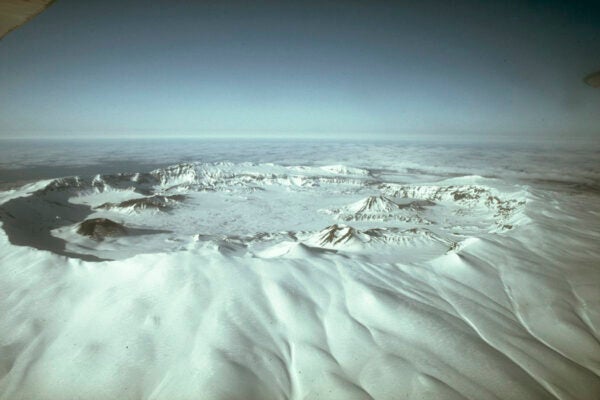
- Beware the Volcanoes of Alaska (and Elsewhere)

Saffron: The Story of the World’s Most Expensive Spice

“Spaghettification”: How Black Holes Stretch Objects into Oblivion

Why Not Just Be a Nurse?
Recent posts.
- She’s All About That Bass
- Cloudy Earth, Colorful Stingrays, and Black Country
- Seeing the World Through Missionaries’ Eyes
- The Border Presidents and Civil Rights
Support JSTOR Daily
Sign up for our weekly newsletter.
- More to Explore
- Series & Movies
Published Jan 13, 2021

The Science Behind Discovery's Burn
Star Trek: Discovery's science consultants take us behind the scenes to explain how The Burn was created.
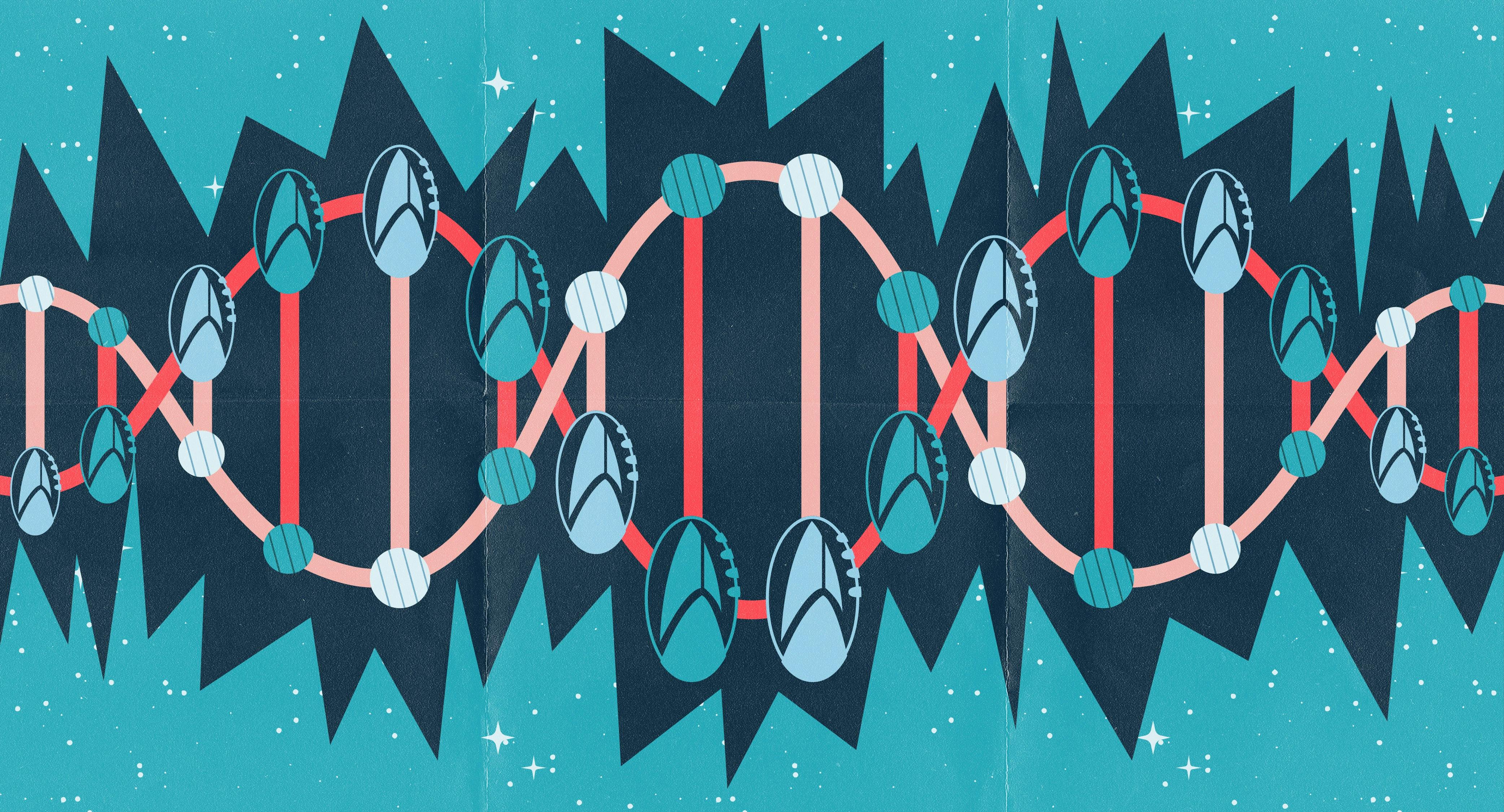
StarTrek.com
In the third season of Star Trek: Discovery , the crew found themselves in the future and faced a new mystery: The Burn. All the crew knew initially was that, around 3069, any active dilithium was rendered inert, resulting in all active warp engines going critical. This restricted warp travel for over a hundred years and fractured the Federation. As the science consultants for Season 3, we helped develop the science behind both dilithium as well as the biology of an alien left in a unique environment that resulted in a galaxy-wide disaster.
First, we need to explore a little more about what dilithium is and how it works in a warp core. Dilithium has played a role in Star Trek from the very beginning. The key to remember is that dilithium is not fuel for the warp engines, but more a regulator. In order to build a warp bubble and “go to warp”, the ship needs an extremely high amount of energy to warp spacetime. In today’s physics, when matter and antimatter (like protons and antiprotons, or electrons and positrons) meet, they annihilate themselves and release energy. For Star Trek , this matter-antimatter reaction provides the energy needed to build a warp bubble. That’s where dilithium comes in: it regulates these reactions to keep them from going out of control or “going critical”.
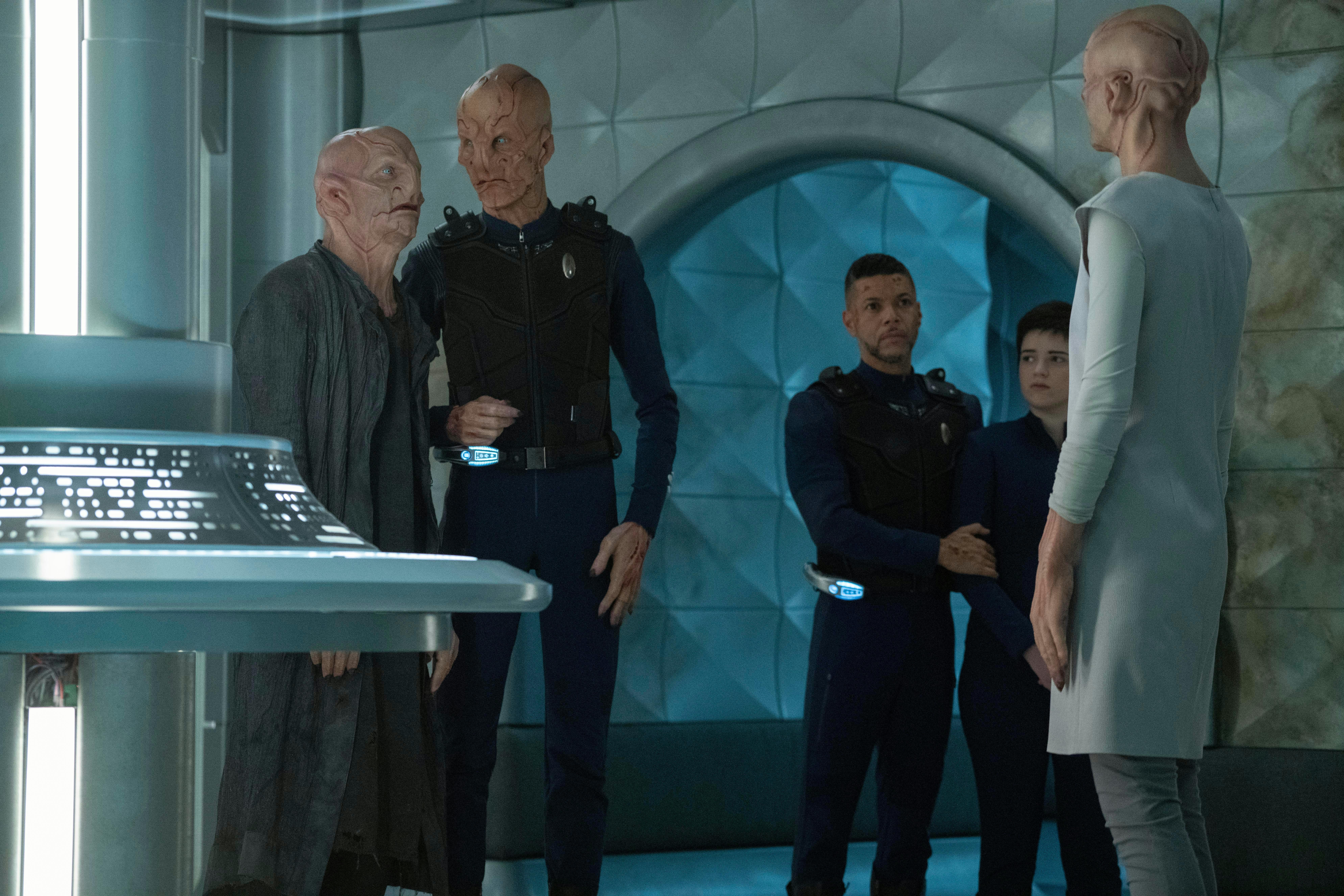
Dilithium may be a fictional crystal from Star Trek , but in that world, it is composed of traditional baryonic matter (which is the stuff all the atoms and elements on the periodic table are made of) as well as complex subatomic particles which exist in subspace that allow the crystalline structure to form. We say “complex” in the sense that subspace, the region outside normal spacetime, can be thought of mathematically as living in a “complex plane”, similar to how imaginary numbers work. The crystalline structure of dilithium that is both in normal as well as subspace (and if you’d like, refers to the “di” part of dilithium) makes it a unique regulator for the amount of energy being released.
The Discovery crew eventually found a link between The Burn and a Kelpien alien named Su’Kal, discovered stranded on a dilithium planet. When Su’Kal screams, he sends out a sort of shockwave that carries through subspace. Su’Kal’s connection to subspace is unprecedented but has biological, and specifically genetic, roots from his exposure to radiation and chemicals (dilithium). Radiation and chemicals can cause DNA letter (A,C,G,T) changes called “mutations”, but genes can also be turned on/ off or turned up/ down in how much product (e.g., RNA) they make in response to radiation or chemicals. Such changes in amounts of gene product produced, called changes in “gene expression,” make sense because many of his cells across his body will respond similarly to external inputs, whereas if changes happened from new mutations, then each of his cells would get distinct mutations, and chaos could ensue. Part of the gene expression response happens through what is called (in real life as well as the show) “epigenetic modification”: the DNA letters are unchanged but may be tagged with a molecule to signal how much product to make. Su’Kal’s exposures therefore caused epigenetic changes which affected his body’s development.
A more specific hypothesis was proposed in the season finale by Dr. Culber: Su’Kal could be a “polyploid”. Rather than having one copy of every gene from mom and one copy from dad, polyploids have two or more from each of their parents. Polyploidy is very rare in mammals on Earth, but it is more common in frogs, fish, and plants, including cotton, potato, and (quadro)triticale. Polyploidy can be induced by radiation and can cause epigenetic changes. Additionally, polyploidy sometimes provides enhanced tolerance to stressful conditions, perhaps including radiation, thereby helping Su’Kal live in his radiation-flooded spaceship. In any case, epigenetic changes, whether through polyploidy or not, were induced by exposure to chemicals and radiation, and they cause Su’Kal to be physically different from other Kelpiens.

Linking the physics and biology from above, the complex subatomic particles allow dilithium to form a crystal structure with a particular resonant frequency. The abundance of these complex subatomic particles in dilithium-forming regions caused them to interact with physical changes in Su’Kal. We propose that the epigenetic changes (or his polyploid nature) caused Su’Kal’s vocal chords to develop in a manner where they resonate at the resonant frequency of the stable crystalline structure that ties dilithium from normal space to subspace. Because of this connection, his crisis permeated normal space as well as subspace. When Su’Kal cried out, he did so at the resonant frequency of the structure of dilithium, causing the subspace and normal-space portions of the crystal to dissociate. Because physics in subspace, the way it’s represented in Star Trek , is not limited to the speed of light, this associated shockwave occurred across a vast stretch of normal space almost instantaneously. While The Burn appeared to happen all at once, the fact that they were able to discern small differences and triangulate the location showed that not only did it occur at one point (the Verubin Nebula), but it had to have permeated subspace since it happened faster than the speed of light (the speed limit of our “normal” space). The dilithium that was actively being used destabilized and an exponential cascading effect of energy generation resulted in an instantaneous critical warp core explosion. Any dilithium that wasn’t being used by warp engines was still affected by this resonant frequency and still fractured, resulting in limitations to the availability and the extent to which it could be used.
The science of Star Trek has had a long legacy alongside creative storytelling. We are honored to have been asked to help the writers of Star Trek: Discovery tell this wonderful story by building a scientific background.
Dr. Erin Macdonald Explains Wormholes
Erin Macdonald (PhD, Astrophysics) (she/her) is an internationally recognized space science expert, writer, speaker, and consultant with a background in gravitational waves and general relativity. She currently lives in Los Angeles and is working as a writer as well as a science consultant for the Star Trek franchise.
Mohamed Noor (PhD, Ecology & Evolution) (he/him) is a Professor of Biology and the Dean of Natural Sciences at Duke University in Durham, NC. He conducts research and teaches in the areas of genetics and evolution. and he is contracted as a science consultant for the Star Trek franchise.
Star Trek: Discovery streams on Paramount+ in the United States, airs on Bell Media’s CTV Sci-Fi Channel and streams on Crave in Canada, and on Netflix in 190 countries.
Get Updates By Email

The U.S.S. Enterprise , depicted here in the 2013 movie Star Trek: Into Darkness , relies on its warp drive to zip across the galaxy.
Inside the Quest for a Real ‘Star Trek’ Warp Drive
It may be a while before starship captains can race across the galaxy, but engineers and physicists have a few ideas for making it so.
Within the Star Trek universe, traveling across the galaxy is a breeze thanks to the famed warp drive . This fictional technology allows humans and other civilizations to zoom between star systems in days rather than centuries.
Such rapid travel times are impossible in the real world, because our best theory for the way the universe works, Einstein’s special relativity , says that nothing moves faster than the speed of light.
While current rocket propulsion systems are bound by this law, plenty of hopeful engineers and physicists are working on concepts that might bring us a step closer to Star Trek ’s vision of racing across the cosmos.
“Currently, even the most advanced ideas behind interstellar travel entail trip times of decades and centuries to even the closest stars, due to the restrictions of special relativity, and our abilities—or lack of—to travel at an appreciable fraction of the speed of light,” says Richard Obousy , director and founder of Icarus Interstellar, a nonprofit dedicated to making progress toward interstellar flight.
“Being able to build starships with the capability to travel faster than the speed of light would open the galaxy for exploration and possible colonization by humans.”
Nuclear Engines
Distances in space are so vast that astronomers usually measure them in light-years, the distance light can travel in a year’s time. A single light-year equals about six trillion miles.
The closest star to our solar system, Proxima Centauri, is 4.23 light-years away, so even traveling at the speed of light, a one-way voyage there would take 4.23 years. That may seem pokey, but it would be a huge improvement over current technology.
FREE BONUS ISSUE
Right now, the fastest spacecraft headed away from Earth is Voyager 1, which is puttering along at about 38,600 miles an hour. At that rate, it would take more than 70,000 years to reach Proxima Centauri.
Still, various teams have proposed ways to at least reach a fraction of light speed and hasten our exploration of interstellar space.
Back in 1958, researchers at San Diego-based defense contractor General Atomics came up with Project Orion , which involved a spacecraft driven essentially by nuclear bombs. A controlled series of nuclear explosions would propel the ship at high speeds, rapidly carrying a hundred tons of cargo and eight astronauts to places like Mars and even the outer solar system.

Faster propulsion technology would allow us to visit our galactic neighbors, like this satellite of the Milky Way known as the Large Magellanic Cloud.
Blueprints were also created showing how to adapt the technology for interstellar travel. However, all experimentation with this so-called nuclear-pulse propulsion came to a halt with the Nuclear Test Ban Treaty of 1963.
Announced earlier this year, the ambitious Breakthrough StarShot initiative represents a less explosive effort to undertake an interstellar mission. Run by a conglomerate of billionaires and big thinkers, including famed physicist Stephen Hawking, the project’s goal is to send a flotilla of postage stamp-size spacecraft to Alpha Centauri, a triple star system that’s 4.3 light-years away. (See “Is the New $100 Million ‘Starshot’ for Real?” )
You May Also Like

U.S. returns to the moon as NASA's Odysseus successfully touches down

What is a sonic boom—and is it dangerous?

NASA smashed an asteroid with a rocket. The debris could hit Mars.
The tiny spacecraft would be attached to a thin light sail, a piece of technology that would allow mission managers to propel the probes with lasers shining from Earth’s orbit. The lasers would accelerate the craft to 20 percent the speed of light, and the probes would arrive at their destination in roughly 20 years.
While many of the tiny travelers may never make it to Alpha Centauri, a few of them should survive and may even fly past any planets orbiting the far-off stars , beaming back data about these alien worlds.
“I’m incredibly excited to see private money being used to explore breakthrough ideas that may advance the field of interstellar flight,” Obousy says.
“I hope to see more like this in the future. While there are engineering challenges associated with the Starshot Initiative, none appear insurmountable.”
Warping Reality
Of course, the real breakthrough would be a true warp drive, which requires technology to catch up with our theoretical designs.
In 1994, Trek fans got a glimmer of hope from Mexican theoretical physicist Miguel Alcubierre, who came up with a radical theory of hyper-fast space propulsion that doesn't break Einstein’s special relativity.
Instead of accelerating the spacecraft itself to light speed, why not bend, or warp, the fabric of space and time around the ship itself? Alcubierre presented calculations that produce a bubble in space-time in which one end is expanding and the other is contracting. A spaceship could, in theory, be carried along with the warp bubble and accelerated to velocities up to 10 times the speed of light.
While that sounds simple on paper, to make it work, we may need to harness exotic forms of matter, like antimatter, that for now are poorly understood. In addition, numerous unsolved issues plague the creation and control of a warp bubble, Obousy says.
“One such problem, for example, is the idea of causal disconnection, which implies that any spacecraft sitting within the bubble would not be able to ‘communicate’ with the exterior of the bubble, suggesting that a ship would not be able to ‘turn off’ the bubble once inside of it,” he notes.
As is often the case in space travel, developing true interstellar travel like what we see in Star Trek will require significant changes in the cost and energy requirements.
“Currently, the amount of energy and money required to entertain the notion of manned interstellar travel is measured in large fractions of global output—specifically, tens of trillions of dollars, and energy measured on the scale of what many large countries use annually,” he says.
Still, he adds, “the finest minds of the 15th century could not have predicted the technological wonders of the 21st century. Similarly, who are we to say what technology the humans of the 27th century will have mastered.”
Andrew Fazekas, the Night Sky Guy, is the author of Star Trek: The Official Guide to Our Universe and host of NG Live! " Mankind to Mars " presentations. Follow him on Twitter , Facebook , and his website .
Related Topics
- TELEVISION AND VIDEO

Why this company sent ancient human fossils into space

Why go back to the moon? NASA’s Artemis program has even bigger ambitions
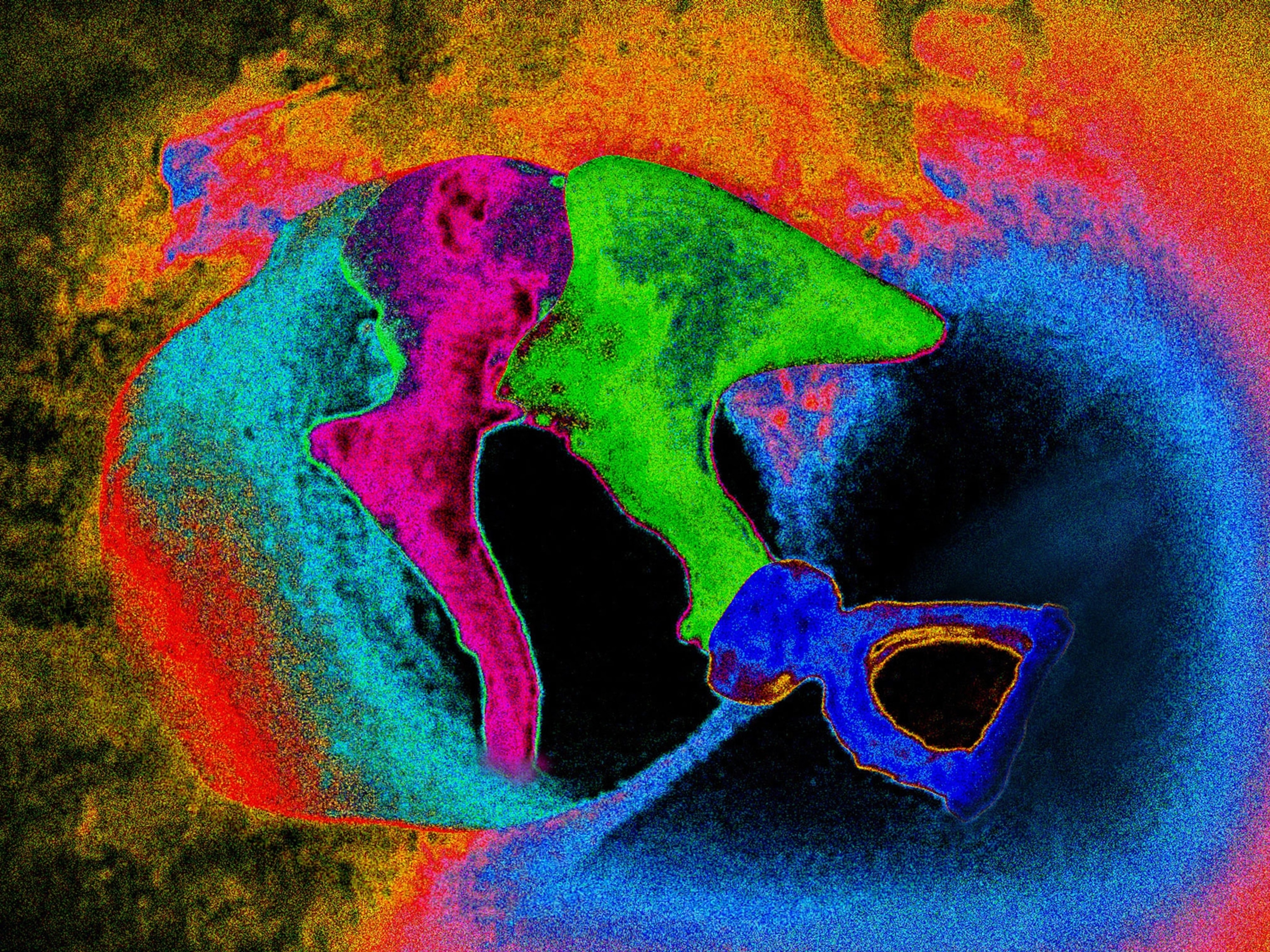
Noise pollution harms more than your hearing

Historic moon lander malfunctions after launch—but NASA isn’t panicked (yet)

Step inside the factory where the NFL’s footballs are made
- History & Culture
- Photography
- Environment
- Paid Content
History & Culture
- Mind, Body, Wonder
- Terms of Use
- Privacy Policy
- Your US State Privacy Rights
- Children's Online Privacy Policy
- Interest-Based Ads
- About Nielsen Measurement
- Do Not Sell or Share My Personal Information
- Nat Geo Home
- Attend a Live Event
- Book a Trip
- Inspire Your Kids
- Shop Nat Geo
- Visit the D.C. Museum
- Learn About Our Impact
- Support Our Mission
- Advertise With Us
- Customer Service
- Renew Subscription
- Manage Your Subscription
- Work at Nat Geo
- Sign Up for Our Newsletters
- Contribute to Protect the Planet
Copyright © 1996-2015 National Geographic Society Copyright © 2015-2024 National Geographic Partners, LLC. All rights reserved
Warp speed, Scotty? It may be possible to travel faster than light
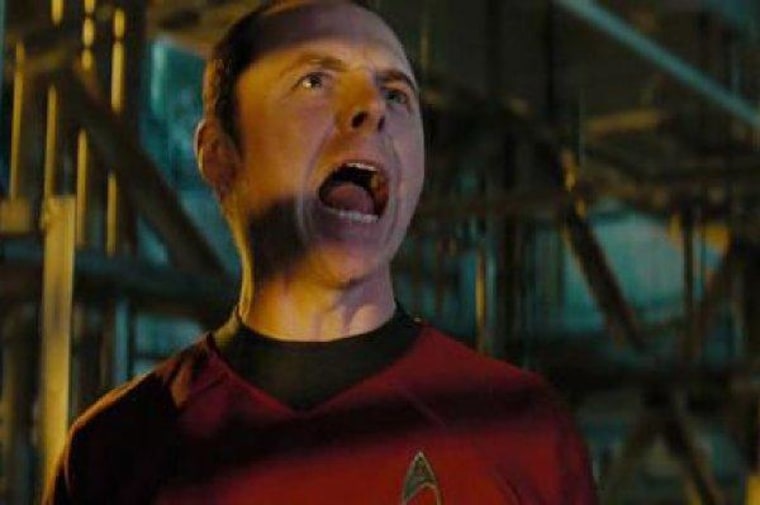
In the "Star Trek" TV shows and films, the U.S.S. Enterprise's warp engine allows the ship to move faster than light, an ability that is, as Spock would say, "highly illogical."
However, there's a loophole in Einstein's general theory of relativity that could allow a ship to traverse vast distances in less time than it would take light. The trick? It's not the starship that's moving — it's the space around it.
In fact, scientists at NASA are right now working on the first practical field test toward proving the possibility of warp drives and faster-than-light travel. Maybe the warp drive on "Star Trek" is possible after all. [See also: Warp Drive: Can It Be Done? (Video) ]
According to Einstein's theory, an object with mass cannot go as fast or faster than the speed of light. The original " Star Trek " series ignored this "universal speed limit" in favor of a ship that could zip around the galaxy in a matter of days instead of decades. They tried to explain the ship's faster-than-light capabilities by powering the warp engine with a "matter-antimatter" engine. Antimatter was a popular field of study in the 1960s, when creator Gene Roddenberry was first writing the series. When matter and antimatter collide, their mass is converted to kinetic energy in keeping with Einstein's mass-energy equivalence formula, E=mc 2 .
In other words, matter-antimatter collision is a potentially powerful source of energy and fuel, but even that wouldn't be enough to propel a starship to faster-than-light speeds.
Nevertheless, it's thanks to "Star Trek" that the word "warp" is now practically synonymous with faster-than-light travel .
Is warp drive possible?
Decades after the original "Star Trek" show had gone off the air, pioneering physicist and avowed Trek fan Miguel Alcubierre argued that maybe a warp drive is possible after all. It just wouldn't work quite the way "Star Trek" thought it did.
Things with mass can't move faster than the speed of light. But what if, instead of the ship moving through space, the space was moving around the ship?
Space doesn't have mass. And we know that it's flexible: space has been expanding at a measurable rate ever since the Big Bang. We know this from observing the light of distant stars — over time, the wavelength of the stars' light as it reaches Earth is lengthened in a process called "redshifting." According to the Doppler effect, this means that the source of the wavelength is moving farther away from the observer — i.e. Earth.
So we know from observing redshifted light that the fabric of space is movable. [See also: What to Wear on a 100-Year Starship Voyage ]
Alcubierre used this knowledge to exploit a loophole in the "universal speed limit." In his theory, the ship never goes faster than the speed of light — instead, space in front of the ship is contracted while space behind it is expanded, allowing the ship to travel distances in less time than light would take. The ship itself remains in what Alcubierre termed a "warp bubble" and, within that bubble, never goes faster than the speed of light.
Since Alcubierre published his paper "The Warp Drive: Hyper-fast travel within general relativity" in 1994, many physicists and science fiction writers have played with his theory —including "Star Trek" itself. [See also: Top 10 Star Trek Technologies ]
Alcubierre's warp drive theory was retroactively incorporated into the "Star Trek" mythos by the 1990s TV series "Star Trek: The Next Generation."
In a way, then, "Star Trek" created its own little grandfather paradox: Though ultimately its theory of faster-than-light travel was heavily flawed, the series established a vocabulary of light-speed travel that Alcubierre eventually formalized in his own warp drive theories.
The Alcubierre warp drive is still theoretical for now. "The truth is that the best ideas sound crazy at first. And then there comes a time when we can't imagine a world without them." That's a statement from the 100 Year Starship organization, a think tank devoted to making Earth what "Star Trek" would call a "warp-capable civilization" within a century.
The first step toward a functional warp drive is to prove that a "warp bubble" is even possible, and that it can be artificially created.
That's exactly what physicist Harold "Sonny" White and a team of researchers at NASA's Johnson Space Center in Texas are doing right now.
NASA's warp drive project
According to Alcubierre's theory, one could create a warp bubble by applying negative energy, or energy created in a vacuum. This process relies on the Casimir effect, which states that a vacuum is not actually a void; instead, a vacuum is actually full of fluctuating electromagnetic waves. Distorting these waves creates negative energy, which possibly distorts space-time, creating a warp bubble.
To see if space-time distortion has occurred in a lab experiment, the researchers shine two highly targeted lasers: one through the site of the vacuum and one through regular space. The researchers will then compare the two beams, and if the wavelength of the one going through the vacuum is lengthened, i.e. redshifted, in any way, they'll know that it passed through a warp bubble. [See also: How Video Games Help Fuel Space Exploration ]
White and his team have been at work for a few months now, but they have yet to get a satisfactory reading. The problem is that the field of negative energy is so small, the laser so precise, that even the smallest seismic motion of the Earth can throw off the results.
When we talked to White, he was in the process of moving the test equipment to a building on the Johnson Space Center campus that was originally built for the Apollo space program. "The lab is seismically isolated, so the whole floor can be floated," White told TechNewsDaily. "But the system hadn't been (activated) for a while so part of the process was, we had the system inspected and tested."
White is now working on recalibrating the laser for the new location. He wouldn't speculate on when his team could expect conclusive data, nor how long until fully actuated warp travel might be possible, but he remains convinced that it's only a matter of time.
"The bottom line is, nature can do it," said White. "So the salient question is, 'can we?'"
- NASA Ad to Play Before New Star Trek Movie | Video
- 5 NASA Inventions That Changed Our Lives
- 10 Inventions That Were Ahead of Their Time
Wolfram Demonstrations Project
The alcubierre warp drive.

- Open in Cloud
- Download to Desktop
- Copy Resource Object
Requires a Wolfram Notebook System
Interact on desktop, mobile and cloud with the free Wolfram Player or other Wolfram Language products .
Do not show again
Every Star Trek fan knows how to travel faster than the speed of light. By means of a warp drive that generates a warp bubble around the spaceship, the traveler can cover thousands of light years in a few hours. Miguel Alcubierre found a space-time metric that not only does this job but is also consistent with Einstein's general theory of relativity. The key idea is to contract space-time in front of the traveler and to expand it behind. Here, you can manipulate the size and the thickness of the warp bubble yourself.
Contributed by: Thomas Mueller (March 2011) Open content licensed under CC BY-NC-SA
Miguel Alcubierre, "The Warp Drive: Hyper-Fast Travel within General Relativity," Class. Quant. Grav. , 11 , 1994 pp. L73-L77.
Related Links
Permanent citation.
Thomas Mueller "The Alcubierre Warp Drive" http://demonstrations.wolfram.com/TheAlcubierreWarpDrive/ Wolfram Demonstrations Project Published: March 7 2011
Share Demonstration
Take advantage of the Wolfram Notebook Emebedder for the recommended user experience.

Related Topics
- 3D Graphics
- Gravitation Theory
TechRepublic
Account information.
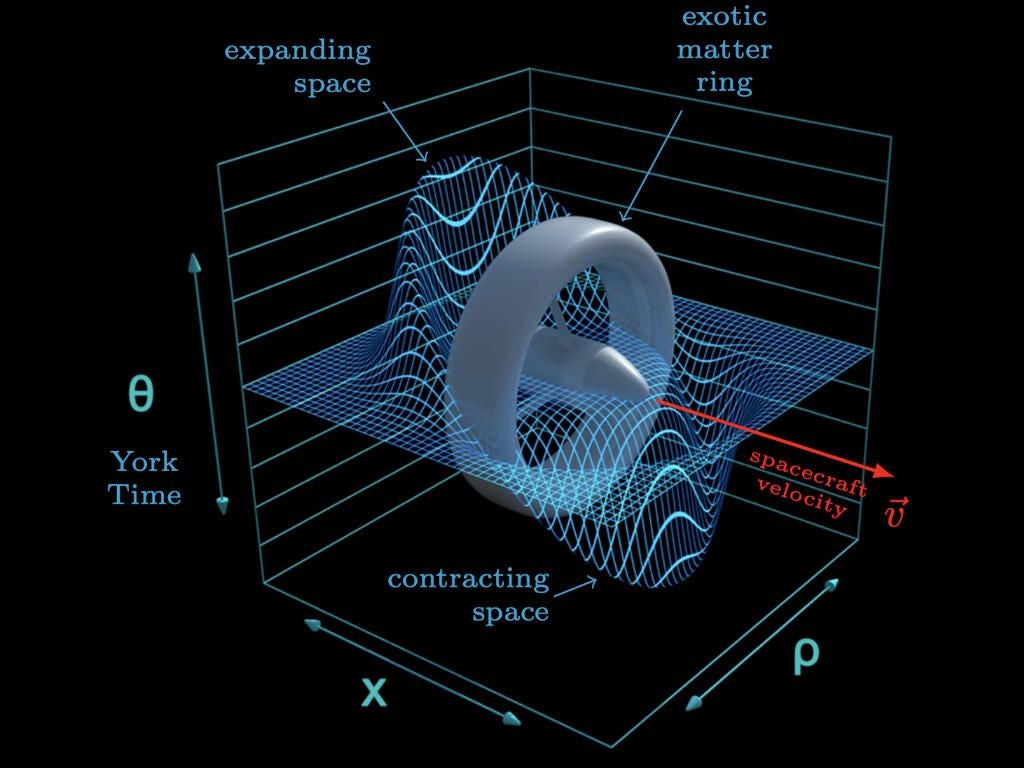
Share with Your Friends
Paging Zefram Cochrane: Humans have figured out how to make a warp bubble
Your email has been sent
Space is vast. Really, really vast. So vast, in fact, that it would take Voyager 1, the furthest man-made object from earth, more than 73 millenia to reach the nearest star to our Sun, Proxima Centauri, at its current speed of over 38,000 mph, if it were headed that way to begin with. In short, if we’re ever going to find a way to explore beyond our own solar system, we need to find a way to bend the laws of physics to make faster-than-light travel possible.
A team of scientists working with DARPA, including warp drive pioneer Dr. Harold G “Sonny” White, may have just taken us one step closer to that reality with the announcement that they’ve discovered a space-warping bubble, the fundamental thing needed for the faster-than-light travel of the Star Trek universe.
SEE: Windows 10 in S mode: A cheat sheet (free PDF) (TechRepublic Premium)
Before we jump ahead to romantic visions of space travel, Dr. White said, we need to think about what we could do with a microscale warp bubble, like the one his team discovered, before even dreaming of what it could be in the future. Dr. White is passionate about space travel, but says we need to start simple. “there may be lots of other things along the way before we ever get there that could have some really interesting implications,” he said.
What is a warp bubble?
This is a pretty complicated notion that involves a ton of math, but at its most basic level, a warp bubble is a bit of space that’s contracted in the front and expanded in the back. The contraction/expansion theoretically pushes the bubble, and its contents, forward at speeds surpassing the speed of light without ever violating the laws of physics: You’re not technically traveling faster than light, you’re surfing a bubble of condensed space.
Warp bubbles are also important because they eliminate a major problem of faster-than-light travel: Time dilation. Say you did manage to travel faster than light: Everything else outside of your craft would speed up, meaning that three-hour tour you took to a nice, tropical planet could have equated to years of time passing on earth. Put simply, if you plan to move faster than light while following the known laws of physics you had better say goodbye to everything you’ve ever loved before heading out.
Again, warp bubbles get around this problem because the space inside the bubble remains unaffected, so an hour of travel at warp speed would mean that only an hour passed for everyone else not currently in a pocket of sci-fi space.
Warp bubbles were long the domain of science fiction, until theoretical physicist Miguel Alcubierre came along and theorized his Alcubierre warp drive in 1994, which maintained general relativity while allowing for faster-than-light travel. The key upon which it rested, was an energy-density field that was configurable into a vacuum bubble that would make anything inside it have negative mass.
Unfortunately, the amount of energy required to operate an Alcubierre drive made it impossible, until 2012 when Dr. White proposed changes to the math and shape of the craft designed to create the field, which lowered the necessary energy from “impossible” to a power source the size of the Voyager 1 spacecraft. Since then, development of an actual warp bubble or Alcubierre drive has continued to be a distant dream.
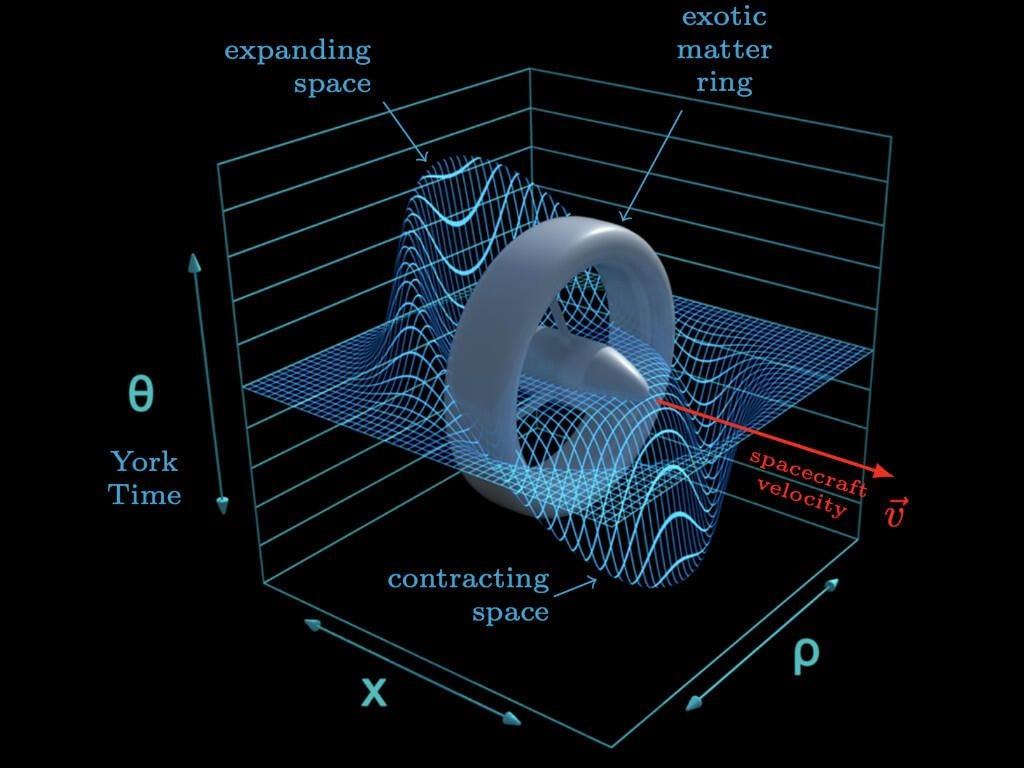
Discovering a warp bubble
Fast forward to 2021, and Dr. White, whose 2012 paper was written while he worked at NASA as Advanced Propulsion Theme Lead, is doing research funded by DARPA on objects called Casimir cavities. These cavities are formed of two parallel plates with a pillar running between them. These things are small — mere microns in size — and they do something really interesting: Create a negative vacuum between the plates when exposed to a regular vacuum.
“You would anticipate zero pressure outside and zero pressure in the cavity, but what we find when we measure is negative pressure in between the plates,” Dr. White said.
“What we’re trying to do is explore the quantum vacuum at a fundamental level,” Dr. White said. “We think there’s a bit more to these vacuums than we currently know. Some of the unknown characteristics could be used to create some really useful technologies.” Hence DARPA’s interest.
These uses could include amazing things, like batteries based around what Dr. White calls “quantum vacuum solar cells” that would never run out of energy. Telecommunications products that use longitudinal waves undisturbed by buildings or natural barriers could be a potential use, as could photosensors that don’t suffer from chromatic aberration because they sense all elements of the EM spectrum evenly.
Potential applications aside, testing those cavities led to an interesting discovery: A negative vacuum energy field that looked just like a two-dimensional slice of an Alcubierre warp bubble.
SEE: Metaverse cheat sheet: Everything you need to know (free PDF) (TechRepublic)
“Our custom Casimir cavities are basically two big planes with a long pole in the middle. The Alcubierre metric, by comparison, needs a total ring of negative vacuum energy density, which means it needs to look more like a lifesaver,” Dr. White said.
Having already done all the math and collected all the data that was generated by the experiment with the 2D version of the bubble that the team observed, the next logical step was to take that data and change the shape of the object in the center, getting rid of the pole and putting in the eerily Vulcan starship-esque shape shown at the top of the article.
After running simulations with the modified shape, the math just added up, Dr. White said. “We did a purposeful analysis using [the warp ship shape], and wow — hey, that matched the Alcubierre metric requirements.”
The warp bubble team has published a paper on their findings , which Dr. White says are in no way illustrative of a warp bubble analog: Their data shows that, given the right shape placed in the same physical cavities they’re experimenting with now, an honest-to-God warp bubble would be created.
“We can identify to the physics community that there is a real world type of structure that we can make that the analysis predicts. It will manifest a negative vacuum energy density, such that it would manifest a real nanoscale warp bubble, not an analog … this would be a real, no kidding nanoscale warp bubble,” Dr. White said.
The 299,792,458 m/s question: When’s first contact?
In the world of Star Trek, the warp bubble works basically the same way: The Enterprise isn’t actually travelling faster than light, it’s just surfing a cosmic space wave generated by its matter/antimatter warp core.
Zefram Cochrane was responsible for building the first functional warp-capable ship in the Trek universe in 2063, at which point the Vulcans, who just happened to be passing by, decided it was time to make first contact and welcome humans into the galactic community. We might be right on course, then, with Dr. White’s team laying the practical groundwork for theoretical concepts that takes us away from Earth and toward the stars.
So, when can humans expect to vacation on Risa, do business on Ferenginar, and study at the Vulcan Science Academy (conditional on meeting the strict entry requirements)? Let’s not get ahead of ourselves, says Dr. White.
“A lot of people wanna get straight into application: when are we gonna go make something like this fly? I get the motivation for that, but science is a slow, arduous process.” Dr. White says his motto has been “crawl, walk, run,” when it comes to this sort of cutting-edge stuff. Dreaming is important, he says, but so is doing the basic research that goes into finding additional applications that are practical and valuable now, in the age where we’re still terrestrially-bound.
SEE: Home video setup: What you need to look and sound professional (TechRepublic)
“I don’t have a crystal ball more than anyone else does. I don’t know when this idea could be applied to space travel, or even if that could even become a reality,” Dr. White said. That’s understandable given we are currently talking about warp bubbles generated in cavities smaller than the width of a human hair.
“Science will continue to turn the crank and hammer the rock, chipping slowly away at some of the unknown to get to more of the known,” said Dr. White. Consider this discovery just one chip in the right direction.
Subscribe to the Innovation Insider Newsletter
Catch up on the latest tech innovations that are changing the world, including IoT, 5G, the latest about phones, security, smart cities, AI, robotics, and more. Delivered Tuesdays and Fridays
- Dark Web: A cheat sheet for professionals
- Linux 101: What tech pros need to know
- Tech history: Check out our coverage
Create a TechRepublic Account
Get the web's best business technology news, tutorials, reviews, trends, and analysis—in your inbox. Let's start with the basics.
* - indicates required fields
Sign in to TechRepublic
Lost your password? Request a new password
Reset Password
Please enter your email adress. You will receive an email message with instructions on how to reset your password.
Check your email for a password reset link. If you didn't receive an email don't forgot to check your spam folder, otherwise contact support .
Welcome. Tell us a little bit about you.
This will help us provide you with customized content.
Want to receive more TechRepublic news?
You're all set.
Thanks for signing up! Keep an eye out for a confirmation email from our team. To ensure any newsletters you subscribed to hit your inbox, make sure to add [email protected] to your contacts list.
- Cast & crew
- User reviews
Remember Me
- Episode aired Oct 20, 1990

Dr. Crusher's fear of losing loved ones becomes real when her worries create an alternate reality. Dr. Crusher's fear of losing loved ones becomes real when her worries create an alternate reality. Dr. Crusher's fear of losing loved ones becomes real when her worries create an alternate reality.
- Gene Roddenberry
- Lee Sheldon
- Ronald D. Moore
- Patrick Stewart
- Jonathan Frakes
- LeVar Burton
- 24 User reviews
- 9 Critic reviews

- Captain Jean-Luc Picard

- Commander William Thomas 'Will' Riker

- Lieutenant Commander Geordi La Forge

- Lieutenant Worf

- Doctor Beverly Crusher

- Counselor Deanna Troi

- Lieutenant Commander Data

- Ensign Wesley Crusher

- The Traveler

- Doctor Dalen Quaice

- Chief Miles O'Brien

- Enterprise Computer
- (uncredited)

- Enterprise-D Ops Officer
- All cast & crew
- Production, box office & more at IMDbPro
Did you know
- Trivia Gates McFadden did all her stunts for the vortex effects sequences. Shortly after performing the stunt where she is thrown from Data's ops console chair, McFadden learned she was pregnant.
- Goofs When Dr. Crusher is on the bridge and she hears the first explosions, a computer graphic shows the warp bubble collapsing onto the ship and a significant portion of the front of the saucer section having already disappeared. Back in Engineering, La Forge and Data notice that the warp bubble is collapsing at the rate of 15 meters per second and will be completely gone in four and a half minutes. That would make the diameter of the warp bubble 4.050 km (roughly 2.5 miles) at that point. The Enterprise D is only 643 meters (2,100 feet) long. Even without knowing the ship's specs, it is evident that the ship is not four kilometers long.
Doctor Beverly Crusher : If there's nothing wrong with me... maybe there's something wrong with the universe.
- Connections Featured in The Chronic Rift: The 1990 Roundtable Awards (1991)
- Soundtracks Star Trek: The Next Generation Main Title Composed by Jerry Goldsmith and Alexander Courage
User reviews 24
- Jan 27, 2021
- October 20, 1990 (United States)
- United States
- Official site
- Paramount Studios - 5555 Melrose Avenue, Hollywood, Los Angeles, California, USA (Studio)
- Paramount Television
- See more company credits at IMDbPro
Technical specs
- Runtime 45 minutes
- Dolby Digital
Related news
Contribute to this page.
- IMDb Answers: Help fill gaps in our data
- Learn more about contributing
More to explore

Recently viewed

COMMENTS
A warp bubble, also known as a static warp bubble or static warp field, is a type of subspace deformation, a warp in the fabric of space. Some individuals, such as those native to the planet Tau Alpha C, were capable of manipulating warp bubbles with their minds. A person could become trapped within a warp bubble; escape would depend on creating a stable threshold between the warp bubble and ...
A warp field, also known as the subspace displacement field or the subspace warp field, was the means by which a warp drive propelled a starship at faster-than-light (or warp factor) speeds. Generated by field coils, usually found in nacelles, the field surrounded the ship, causing the space around the ship to distort by the creation of a warp bubble. The warp field, also known as a subspace ...
As the warp bubble shrinks, erasing parts of the Enterprise, she races for Engineering, the center of the warp bubble, and finds a vortex waiting there. ... In 2021, Screen Rant said this was an instance of a Star Trek episode exploring fear of being alone. Home video
The Alcubierre metric defines the warp-drive spacetime. It is a Lorentzian manifold that, if interpreted in the context of general relativity, allows a warp bubble to appear in previously flat spacetime and move away at effectively faster-than-light speed. The interior of the bubble is an inertial reference frame and inhabitants experience no ...
Warp drive or warp engine was a technology that allowed space travel at faster-than-light speeds. It worked by generating warp fields to form a subspace bubble that enveloped the starship, distorting the local spacetime continuum and moving the starship at velocities that could greatly exceed the speed of light. These velocities were referred to as warp factors. Warp drive was the most common ...
For Erik Lentz, it all started with Star Trek. Every few episodes of Star Trek: The Next Generation, Captain Jean-Luc Picard would raise his hand and order, "Warp one, engage!". Then stars ...
Star Trek and FTL Travel. Anyone who has seen the show Star Trek knows that the starship Enterprise travels from one adventure to another using the warp engine, a device that allows FTL (faster than light) travel. However, people point out that such a feat should be impossible due to Einstein's Theory of Relativity, which states that nothing can travel faster than the speed of light.
Season 2 of the critically acclaimed Star Trek: Strange New Worlds premiered June 15 (streaming on Paramount+). ... One bubble for warp 1, another bubble around that first bubble for warp 2 and so on.
The Emit Unstable Warp Bubble disables launching fighters, hazards, fields and platforms for 20 seconds, as well as preventing the activation of abilities such as Saucer Separation. It is one of the rewards for completing "Broken Circle". Profession: Engineering Locale: Space Game Description: Emit an unstable warp bubble from your warp core, dampening the space-subspace interactions on ...
A warp drive or a drive enabling space warp is a fictional superluminal (faster than the speed of light) spacecraft propulsion system in many science fiction works, most notably Star Trek, and a subject of ongoing physics research. The general concept of "warp drive" was introduced by John W. Campbell in his 1957 novel Islands of Space and was popularized by the Star Trek series.
According to Star Trek canon, the warp drive works by creating a "warp bubble" around the spaceship, inside of which space is literally warped. In front of the spaceship, space is compressed, while behind the vessel, it is expanded. In this way, a spaceship never travels faster than light; it merely passes through a shorter distance.
Star Trek Science Advisor Dr. Erin MacDonald explains the science behind warp bubbles. Star Trek: Prodigy is coming soon to Netflix and in Canada on CTV.ca and the CTV App, and is currently available on SkyShowtime in the Nordics, the Netherlands, Portugal, Spain, and Central and Eastern Europe. Stay tuned to StarTrek.com for more details! And ...
The remark isn't entirely correct [in Star Trek lore of course]: The ships don't actually travel faster than light, they create a warp bubble around the ships, and it's the warp bubble, warping space-time, that moves. The ship barely moves at all inside the bubble.
For Star Trek, this matter-antimatter reaction provides the energy needed to build a warp bubble. That's where dilithium comes in: it regulates these reactions to keep them from going out of control or "going critical". ... Star Trek: Discovery streams on Paramount+ in the United States, airs on Bell Media's CTV Sci-Fi Channel and ...
Inside the Quest for a Real 'Star Trek' Warp Drive. ... A spaceship could, in theory, be carried along with the warp bubble and accelerated to velocities up to 10 times the speed of light.
Maybe the warp drive on "Star Trek" is possible after all. ... The ship itself remains in what Alcubierre termed a "warp bubble" and, within that bubble, never goes faster than the speed of light.
Every Star Trek fan knows how to travel faster than the speed of light. By means of a warp drive that generates a warp bubble around the spaceship, the traveler can cover thousands of light years in a few hours. Miguel Alcubierre found a space-time metric that not only does this job but is also consistent with Einstein's general theory of ...
Short but awesome; the brand-spanking-new warp FX from Star Trek Beyond. The first time we've ever seen the warp bubble and the bending and warping of spacet...
In the world of Star Trek, the warp bubble works basically the same way: The Enterprise isn't actually travelling faster than light, it's just surfing a cosmic space wave generated by its ...
That makes for a boring sci-fi plot, so the creators of Star Trek invented a convenient, but imaginary, technology. According to Star Trek canon, the warp drive works by creating a "warp bubble ...
Remember Me: Directed by Cliff Bole. With Patrick Stewart, Jonathan Frakes, LeVar Burton, Michael Dorn. Dr. Crusher's fear of losing loved ones becomes real when her worries create an alternate reality.
Exclusive to Pack - Universal Kit Module - Warp Bubble Ruptures; 6 Starship Slots; 6 Experimental Upgrade Tokens; 13 Ultimate Tech Upgrades; 13 Master Keys; Exclusive to Pack - Title "Storm Chaser" The 13 th Anniversary Terran Bundle will have a base price of 17,500 Zen, but will be offered at the Discounted Price of 13,125 (25% Off ...
[Universal Kit Frame - Warp Bubble Ruptures] Terran EV Suit Terran Dr. Beverly Crusher Holographic Bridge Officer. ... This is the unofficial community subreddit for Star Trek Online, the licensed Star Trek MMO, available on PC, Playstation, and Xbox. Share your glorious (or hilarious) in-game adventures through stories and screencaps, ask your ...